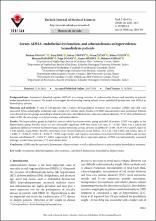Serum ADMA, endothelial dysfunction, and atherosclerosis in hypervolemic hemodialysis patients

View/
Access
info:eu-repo/semantics/openAccessAttribution 4.0 International (CC BY 4.0)https://creativecommons.org/licenses/by/4.0/deedDate
2018Author
Doğan, İbrahimEser, Barış
Özkurt, Sultan
Yayar, Özlem
Özgür, Bülent
Kayadibi, Hüseyin
Doğan, Tolga
Musmul, Ahmet
Soydan, Mehmet
Metadata
Show full item recordCitation
Doğan, İ., Eser, B., Özkurt, S., Yayar, Ö., Özgür, B., Kayadibi, H., Doğan, T., Muşmul, A., Soydan, M. (2018). Serum ADMA, endothelial dysfunction, and atherosclerosis in hypervolemic hemodialysis patients. Turkish Journal of Medical Sciences, 48(5), 1041-1047.Abstract
Background/aim: Asymmetric dimethyl arginine (ADMA) is a strong predictor of cardiovascular disease and mortality in patients under hemodialysis treatment. We aimed to investigate the relationship among volume status, endothelial dysfunction, and ADMA in hemodialysis patients. Materials and methods: A total of 120 patients with a history of hemodialysis treatment were included. ADMA and CRP were measured. Echocardiographic evaluation and carotid artery intima–media thickness (CIMT) measurements were performed. Patients were divided into two groups according to clinical evaluation, ultrafiltration rate, vena cava inferior diameter (VCI), and cardiothoracic index (CTI); the two groups were hypervolemic and normovolemic. Results: The hypervolemic group included 61 patients while the normovolemic group included 59 patients. CIMT was higher in the hypervolemic group, but this result was not statistically significant (0.95 mm versus 0.85 mm, P = 0.232). There was a statistically significant difference between the hypervolemic and normovolemic groups in terms of ADMA (P < 0.001) (0.69 ± 0.57 µmol/L and 0.41 ± 0.04 µmol/L, respectively). Positive correlations were observed between serum ADMA, VCI, CTI, CRP, CIMT, and cardiac mass (P < 0.001, P = 0.016, P < 0.001, P = 0.006, P = 0.022, respectively), and negative correlations were observed between ADMA and ejection fraction and albumin (P = 0.024, P = 0.024, respectively). In multiple linear regression analysis, ADMA was independently associated with age, systolic blood pressure, CTI, and volume status. Conclusion: ADMA may be a potential determinant of hypervolemia as well as atherosclerosis in patients under hemodialysis treatment. © TÜBİTAK.
Source
Turkish Journal of Medical SciencesVolume
48Issue
5Collections
- Makale Koleksiyonu [198]
- Makale Koleksiyonu [517]
- Scopus İndeksli Yayınlar Koleksiyonu [2695]
- WoS İndeksli Yayınlar Koleksiyonu [2986]


















